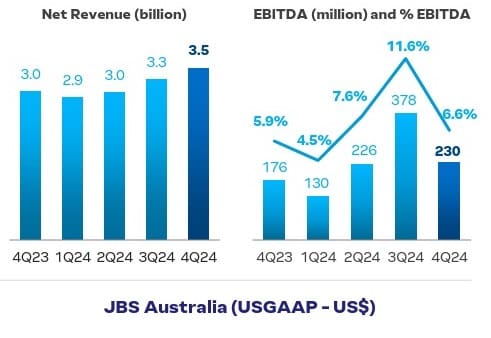GLOBAL animal protein giant JBS reported 2024 full-year results this morning, Australian time, delivering a net profit of US$1.8 billion for the year, down almost $200m on the year before.
Net revenue reached a new company record US$77.2 billion, up 6pc year on year, while adjusted pre-tax earnings were US$7.2 billion, more than double a year earlier. (All figures below in US$, unless otherwise advised).
 In addition to its Australian operations encompassing beef, lamb, pork, aquaculture and smallgoods, JBS operates enormous beef and value-added divisions in South America, plus beef, pork and chicken divisions in North America.
In addition to its Australian operations encompassing beef, lamb, pork, aquaculture and smallgoods, JBS operates enormous beef and value-added divisions in South America, plus beef, pork and chicken divisions in North America.
JBS Global chief executive Gilberto Tomazoni told investors the results reflected the strength of JBS’s global multi-protein platform and the precision of its operational strategy, which enabled it to capitalise on opportunities across varied market cycles and geographies.
JBS’s North America Beef division surprised many analysts, delivering results that outperformed 2023, despite headwinds in the US market. Net sales reached US$24.3b, up 4pc on the previous year, while adjusted EBITDA was US$247m, up 117pc.
Beef processing margins in North America continued to be pressured by the cattle cycle, despite strong consumer demand, shareholders were told. According to data released by the USDA, both beef cattle prices and cutout prices reached record levels throughout 2024. However, the growth in cattle prices outpaced the growth in cutout prices.
Therefore, as cattle represent approximately 85pc of the cost of products sold (see more of CoGS below), US Beef profitability was pressured during the period, JBS said.
In Australia, where the cycle is expected to remain favourable in the coming quarters, a 7pc increase in net sales to US$6.6 billion (+$10b in Aussie currency) partly reflected the increase in beef and lamb exports, especially to the United States. Adjusted pre-tax earnings were US$664m, up 46pc year-on-year.
 “The strong revenue growth in the Australian beef business, compared to the prior year, reflected the higher volumes sold in exports, in addition to the increase in average meat prices, despite the higher cost of cattle,” JBS told shareholders.
“The strong revenue growth in the Australian beef business, compared to the prior year, reflected the higher volumes sold in exports, in addition to the increase in average meat prices, despite the higher cost of cattle,” JBS told shareholders.
Meat & Livestock Australia reported Australian cattle prices increased by 47pc in the fourth quarter ended December, compared with the same period a year earlier, putting pressure on JBS’s Australian profitability in the quarter.
“For the full 2024 year, the improvement in Australian profitability reflected the operational efficiencies achieved through cost-reduction initiatives and the increase in processed volumes, driven by the greater availability of animals,” the company told shareholders.
JBS’s Australian aquaculture business reported a drop in net revenue in the fourth quarter and in the full year, due to lower volumes sold, given the lower fish processing in the periods following operational disruptions, due to weather consequences. Net revenue from the Australian pork business grew 4pc in 2024, compared to the same period last year.
At Primo, JBS’s Australian smallgoods and value-adding business, despite lower volumes sold in the face of continued inflationary pressures, the company reported an increase in pre-tax earnings margin for the year, as a result of operational efficiencies and cost-saving initiatives.
In South America, JBS’s beef business had net sales of US$12.6b, up 13pc year on year, with adjusted pre-tax earnings of $965m, up 106pc, driven by record beef volumes, growth in both domestic and international markets, productivity gains, and new export certifications.
The Seara Brazilian value-added business covering all proteins posted a strong recovery, with net sales of $8.8b up 6pc, and adjusted EBITDA of $1.5b, up 322pc. This performance reflected gains from the commercial and operational improvements made throughout the year – although JBS still sees room for improvement, particularly in pricing, product mix, and premium categories.
“Our geographic and protein diversification also allowed us to benefit from the favourable cattle cycles in Australia and Brazil, even as margins in the US remained under pressure due to the region’s cattle dynamics,” Mr Tomazoni said.
Given the company’s strong cash position and low leverage, JBS has proposed a dividend of US35c/share, to be paid following shareholder approval.
US stock market listing
Mr Tomazoni also provided an update on JBS’s proposed dual public listing, in the US and Brazil.
“We remain focused on unlocking long-term value through the dual listing of our shares in Brazil and the US,” he said.
“This initiative will strengthen our corporate governance and expand our investor base, attracting institutional investors with significant capital allocation capabilities. We firmly believe this move will drive lasting value for our shareholders, team-members, and areas around the world where we operate.”
Innovation
Mr Tomazoni said the company’s global diversification strategy remained intact, supported by continuous investment in innovation and brand development, allowing it to build a more resilient and higher-value portfolio.
“We’re also advancing in research and biotechnology to develop innovative products and solutions that enhance the productivity of our portfolio and support the development of alternative proteins,” he said.
In Brazil, JBS is building a Biotech Innovation Centre, a new hub for biotechnology research and development.
Earlier this year, the company entered the egg category for the first time, through the acquisition of a 50pc stake in Mantiqueira, the largest table egg producer in South America.
The company also plans to spend US$200m to upgrade two of its largest beef processing facilities in the US, aiming to enhance efficiency and add value.
Investment plans are also rolling out in Nigeria, one of the fastest-growing populations in the world, expected to reach 400 million by 2050, up from 250 million today. In partnership with the Nigerian government and local entrepreneurs, JBS is developing sustainable local supply chains to expand food production.
“Our goal is to support the country in its efforts to combat food insecurity,” Mr Tomazoni said.
Cost of Goods Sold
JBS’s quarterly financials provide a handy Cost of Goods Sold (CoGS) breakdown for each division. The table below plots CoGS for the fourth quarter ended December, providing a handy comparison from region to region.
As the table shows, raw material cost (expressed as a percentage of overall COGS) was 88.9pc in the company’s US Beef division, 77.3pc in Australia (all species, not just beef), and 89.4pc in Brazil. The US number is only likely to go higher, as US cattle prices surge to dizzy limits due to the herd reduction now at 60 year lows.
Labour cost as a percentage of COGS was 6.4pc in the US beef division, 15.2pc in Australia (almost two and a half times as high), and just 4.4pc in Brazil.
